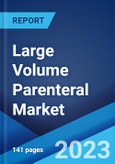A large volume parenteral (LVP) is a single-dose injection packaged in a glass bottle or a flexible container of more than 100ml capacity after sterilization via heat. It is injected through the skin or other external boundary tissue to directly administrate the active drug substances into the blood vessels, organs, tissues, or lesions. It generally consists of an active ingredient, water-miscible or non-aqueous vehicle, and added substances like buffers, antioxidants, preservatives, surfactants, antimicrobial agents, and tonicity adjusters. Some of the commonly available LVPs around the world are peritoneal dialysis, irrigating solutions, blood derivatives, drug premixes, and contrast agents.
Large Volume Parenteral (LVP) Market Trends:
The rising prevalence of malnutrition, growing natality rate, and increasing premature births worldwide are among the key factors catalyzing the demand for LVPs to administer a large amount of nutrients in patients who are unable to take food orally. Apart from this, they are widely used in administering essential nutrients to patients undergoing treatment for esophageal obstruction, gastrointestinal (GI) diseases, cancer, and ulcer. In addition, LVPs find extensive application in heart surgery to prevent ischemic injury to the myocardium during reperfusion and the blood flow supply restriction. This, in confluence with the escalating demand for safe, fast, and effective methods of drug administration among patients undergoing surgical interventions, is contributing to the market growth. Besides this, the growing consumption of fast food across the globe has resulted in rising instances of non-communicable diseases, such as hypertension, diabetes, obesity, and other metabolic disorders. This, in turn, is positively influencing the adoption of LVPs that are a mixture of dextrose, amino acids, lipids, added electrolytes, trace metals, and vitamins.Key Market Segmentation:
The publisher provides an analysis of the key trends in each sub-segment of the global large volume parenteral (LVP) market report, along with forecasts at the global, regional and country level from 2023-2028. The report has categorized the market based on type, volume, application and end users.Breakup by Type:
- Soft Bag LVP
- Plastic Bottle LVP
- Glass Bottle LVP
Breakup by Volume:
100 ML - 250 ML250 ML - 500 ML
500 ML - 1000 ML
1000 ML - 2000 ML
2000 ML and More
Breakup by Application:
- Therapeutic Injections
- Fluid Balance Injections
- Nutritious Injections
Breakup by End Users:
- Hospitals
- Clinics
- Others
Breakup by Region:
- North America
- United States
- Canada
- Asia-Pacific
- China
- Japan
- India
- South Korea
- Australia
- Indonesia
- Others
- Europe
- Germany
- France
- United Kingdom
- Italy
- Spain
- Russia
- Others
- Latin America
- Brazil
- Mexico
- Others
- Middle East and Africa
Competitive Landscape:
The competitive landscape of the industry has also been examined along with the profiles of the key players being Albert David Ltd., B. Braun Melsungen AG, Baxter International Inc., BML Parenteral Drugs, Fresenius Kabi AG, Grifols S.A, Otsuka Pharmaceutical Co. Ltd, Pharmaceutical Solutions Industry Ltd., Sichuan Kelun Pharmaceutical Co. Ltd. and Thermo Fisher Scientific Inc.Key Questions Answered in This Report:
- How has the global large volume parenteral (LVP) market performed so far and how will it perform in the coming years?
- What has been the impact of COVID-19 on the global large volume parenteral (LVP) market?
- What are the key regional markets?
- What is the breakup of the market based on the type?
- What is the breakup of the market based on the volume?
- What is the breakup of the market based on the application?
- What is the breakup of the market based on the end users?
- What are the various stages in the value chain of the industry?
- What are the key driving factors and challenges in the industry?
- What is the structure of the global large volume parenteral (LVP) market and who are the key players?
- What is the degree of competition in the industry?
Table of Contents
Companies Mentioned
- Albert David Ltd.
- B. Braun Melsungen AG
- Baxter International Inc.
- BML Parenteral Drugs
- Fresenius Kabi AG
- Grifols S.A
- Otsuka Pharmaceutical Co. Ltd
- Pharmaceutical Solutions Industry Ltd.
- Sichuan Kelun Pharmaceutical Co. Ltd.
- Thermo Fisher Scientific Inc.
Methodology

LOADING...
Table Information
| Report Attribute | Details |
|---|---|
| No. of Pages | 141 |
| Published | September 2023 |
| Forecast Period | 2022 - 2028 |
| Estimated Market Value ( USD | $ 9.2 Billion |
| Forecasted Market Value ( USD | $ 13.8 Billion |
| Compound Annual Growth Rate | 7.0% |
| Regions Covered | Global |
| No. of Companies Mentioned | 10 |









